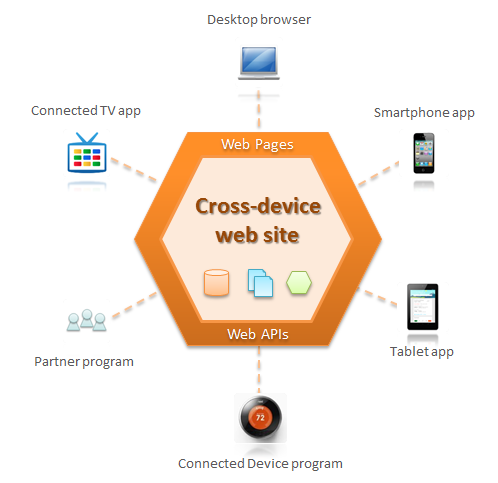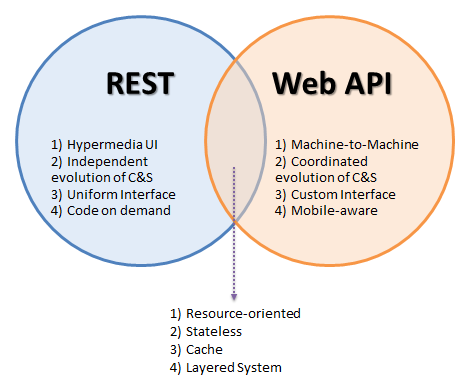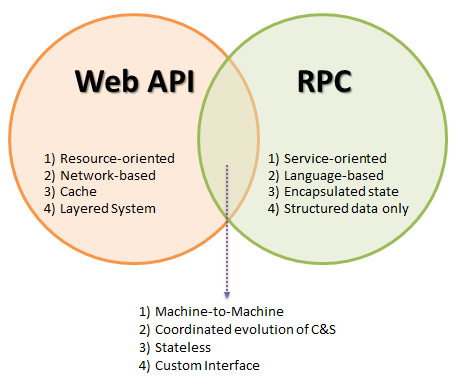Web APIs are designed for systems that are both distributed and driven by machine-to-machine interactions. The Web API style
is the result of the evolution of pragmatic development practices since 2000, starting with the emergence of Web Services (WS-* and *-RPC) and then
the strong influence of the REST style towards more simplification and proper usage of HTTP as an application level protocol rather than a lower-level
transport protocol.
By combining the power of REST (the web of documents) and of Web APIs (the programmable web), we can build a new generation of web sites that are
inherently cross-device. as illustrated below.

Those web sites let organizations of all sizes provide a pervasive and contextual access to their information and services, to both customers,
employees and partners via potentially any kind of machine.
Cross-device web sites illustrate the strategic value brought by Web APIs in this new era of internet mobility.
Starting with the Null style, we will add constraints to obtain the desired Web API style and explain the resulting
properties.
- separation of concerns
- client = program with varying concerns (maximum reusability needs)
- server = data or logic accessibility concerns (build ecosystems of innovation)
- independent evolution of clients and servers at Application scale
- significant difference from REST
Identical to the REST style.
Identical to the REST style.
- predefined set of resources including identifiers and representations
- cool URIs that don’t change
- developers friendly URI naming based on conventions
- more efficient than dynamic discovery
- requires coordination between clients and servers when changes are deployed
- based on explicit versionning
- efficient for both small-grain mobile data transfers as well as large-grain data transfers
- based on parameterized resources and content negotiation
- not optimal for other forms of architectural interaction
- sub-constraints
- identification of resources via URIs (identical to REST)
- manipulation of resources through low-level HTTP clients (using for example raw JSON or XML representations)
- manipulation of resources through high-level client SDKs (for major programming environments) when available
- developer documentation to help with understanding of the interface
- significant difference from REST
Identical to the REST style.
- intermittent Internet connectivity
- potentially unavailable for a long time
- requires an off-line application mode
- expansive Internet connectivity
- typical mobile data plans have data limits per months
- ability to switch to less expansive radio networks when available
- highly dependent on actual client location
- irregular bandwidth (potentially very low)
- adjust media size dynamically
- irregular latency (potential very high)
- aggressively use cache (by default)
- synchronize cache when possible
- not present in REST
As you can see the Web API style has been very much influenced by REST and share many of its constraints.
This influence over 10 years has resulted in key simplifications compared to the original RPC style to make
it more aligned with the core Web concepts such as resources, URIs, representations and the HTTP protocol.
There is no reason to oppose both styles as they are not solving the same problems, even though they are
both deeply connected with the Web. The figure below represents their main differences.

Both styles are complementary and can be used together, for example when building a single page web application
where the main HTML is loaded through a regular web page (REST style), including some JavaScript (code on
demand constraint). This code is then interpreted by the web browser to make AJAX calls back to a Web API,
exchanging predefined JSON representations.
Let’s also mention hyperdata as a second form of hypermedia with hypertext, that also offers a comprehensive
application of REST. This is the world of the Semantic Web and especially the pragmatic Linked Data movement
based on RDF and related media types such as Turtle, JSON-LD or HAL.
In other situations, where the client isn’t a web browser but a native mobile app, a connected device or a
program written by a partner to integrate your web site with their own, you only rely on the Web API style,
which is fine again. Let’s now step back and see where these new forms of web architectures will lead us.


